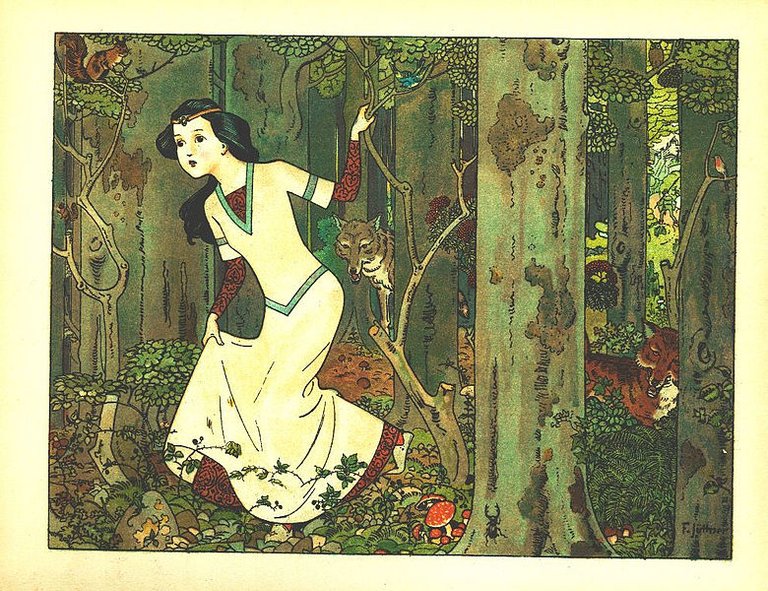In every legend and in every myth there’s always a small grain of truth, but sometimes it might come from a reality so far away we cannot recognize or understand it. Details may vary or change, being retold so many times, but there's always an element of truth.The stories we tell our children are full of fantastic creatures, be they elves, dragons or pixies, and we take them as such, but for the story-tellers of long ago they must have had some meaning. Likewise, we accept the plots and such fundamental characters like the innocent princess, the valiant prince or the evil witch, although we can no longer understand the hidden references to a reality that is long gone. In this new series we will explore the meaning and origins of some well-known stories and legends, in an attempt to understand how these stories came to be.
Her face is one of the most easily recognizable symbols of our times. We grew up with her and our children are now growing up with Snow White, too. While reading the story or watching the movie have you ever wondered what's behind this cruel tale?
Experts believe that the story, first published by the Grimm brothers in 1812, was inspired by the true life story of a German noble woman, Margaretha von Waldeck (1533 – 1554). Margaretha was considered to be an exquisite beauty and she did have a step mother. In 1549, the girl was sent to Brussels, to the court of Mary of Hungary, sister of Charles V, Holy Roman Emperor. It is here that she met Crown Prince Philip, the son of Charles V. Legend has it that Philip wanted to marry her, but his father had other plans, so Margaretha was poisoned. Not with an apple, but slowly over several months. The few surviving letters Margaretha wrote to her family indicate a progressive tremor of the hand, consistent with poisoning. She died at age 21.
The wicked queen was innocent
Contrary to what the Grimm brothers and subsequently Disney would want you to believe, Margaretha's stepmother was innocent, as she died in 1546, eight years before Snow White.
However, it is easy to see how the wicked stepmother motive was inserted in this story and countless others, for one very good reason. Hundreds and thousands of years ago, women frequently died in childbirth, as was the case with Margaretha's real mom, and the widowers usually remarried. Rich men or poor men, they all needed a new wife to take care of the house and the children. And stepmothers obviously cared more about their own offspring. Not necessarily because they were evil, we humans are conditioned to further the species by ensuring our genes live on in our children.
In noble families, stepmothers tried to have their own children inherit titles and fortunes,while in poor families it was more a question of resources. Like giving a red shiny apple to their own kid and leaving the half-rotten one to the stepchild. It’s not just Snow White, think of Cinderella having to work all day, while her stepsisters lived in luxury and tried to get their hands on the prince. Basically, having a stepmom in those times was never easy. People listening and re-telling the story were well-aware of the basics facts of life and this is probably how that poor woman got portrayed as the evil witch.
The stepmother motif is quite frequent in European and Asian folklore, but less so among Africans and Native Americans. One of the reasons for this difference is that while African society rested heavily on strong tribal structures and polygamous families, in Europe, for thousands of years now, society was based on the family unit. Children were not cared for by a whole tribe or several wives. For Europeans it was every family fending for itself and fighting for its survival under often dire economic conditions. In times of hardship, it was only natural for a stepmother to favor her own children and make sure they survive.
Evolutionary psychology describes the abuse inflicted upon stepchildren as the Cinderella Effect.
If the evil queen in Snow White is said to be motivated by jealousy and the one in Cinderella is just evil, the story of Hansel and Gretel puts it quite clearly in terms of survival. The two children are left in the woods, because the parents have too little food to feed them all. The stepmother who comes up with the plan is putting her survival first and that of her future offspring. Why waste precious food on somebody else’s children?
In Europe, one of the earliest mentions of the evil stepmother concept comes from Roman historian Tacitus, who painted Lucia, wife of Emperor Octavian Augustus, as a scheming woman who murdered her husbands adopted grandsons and designated heirs to pave the way for her own son Tiberius to become emperor.

Vailisa ends up in the woods
source
There are countless stories that use the evil stepmother trope. The Russians have the story of ‘Vasilisa The Beautiful’, given impossible tasks by her stepmother. In Romania we have ‘The Old Man’s Daughter and the Old Hag’s Daughter’, where the stepmother and her lazy daughter are abusive towards the kind soft-spoken stepdaughter.
Good always prevails in folk stories, the innocent girl is vindicated, although, in real life, probably not so much.
Dwarfs and child miners
Back to our analysis of Snow White, another interesting part of the story is that of the seven dwarfs. According to experts, their appearance in the story might have something to do with the fact that the von Waldeck family owned several copper mines. No, the mines did not employ dwarfs, but children. Due to the conditions in the mines, their growth was stunted and they remained short and dwarf-like. So much for the sweet Dopey! So much for the merry Hi-Ho song we all know!
This has nothing to do with the age Margaretha von Waldeck lived. Archeological studies suggest that kids had been used to dig out cooper mines thousands of years before. They still do to this days in countries like Congo.
According to World Vision, today's child miners suffer an incredible array of health problems, the hard work affecting their bones and muscles.
However, another version of Snow White, called ’Maria, the Wicked Stepmother and the Seven Robbers’ has the young princess living in the house of some thieves.
Finally, there's the troubling ending of the story with the prince falling in love with Snow White's corpse, a necrophiliac twist that is hard to understand. But, keeping in mind that Margaretha was the victim of the story it is possible that this part was actually meant to signify the fact that she was a saint. The story clearly says her body remained intact, uncorrupted by death, which is what usually happens to the bodies of saints in the Catholic church.
I would like to hear from you about variations on the Snow White character and other stories employing the evil stepmother trope.
Post authored by @ladyrebecca.
References: 1, 2, 3.
Click on the coin to join our Discord Chat

Witness proposal is here:
Go To Steem Witness Page
In the bottom of the page type: adsactly-witness and press vote.

Use small letters and no "@" sign. Or, click here to vote directly!
Thank you!




Wow! I must be sincere and recognize that many of the things you say here, I did not know. Obviously one can intuit which is the real motive behind the representation of the stepmother, but one thing is that one imagines it and another very different that there are studies on the subject. I know for example that some fairy tales were really made to teach young people and children of certain times. On more than one occasion I have read versions of stories in which the evil witch and stepmother is not so evil, as is the case of a story by Bérbely Pérez Rego that versions Snow White and shows how she uses botox and biopolymers, and that is why she is the most beautiful in the city. Also, as a teacher, I've done some creative exercises where students must version the fairy tales themselves and great things come out. As always, thank you for this excellent post, @ladyrebecca.
A very sharp and documented post, @ladyrebecca, as well as beautifully illustrated. Your series promises to be very interesting.
I didn't know the historical data you provide to correlate with Snow White's tale. Yes, I would like to emphasize that the Brothers Grimm were fundamentally compilers and recreators of oral tales belonging to the rural popular tradition. Let's remember that with German Romanticism something begun by Charles Perrault in France in the 17th century is taken up again: the interest in popular knowledge (folklore as it will be called). So, we are before versions, which as such can include modifications, whether by addition, turns, suppressions, attenuations, sweetenings, etc..
Thanks for your good post, @ladyrebecca. Greetings.
Subsequent editions of Grimm's collection of tales do contain various modifications, some of them dictated by the need to make the stories more appropriate for a wider audience, especially children.
Oh boy... the necrophiliac prince. The original stories written by the Grimm brothers are really grim. 😉